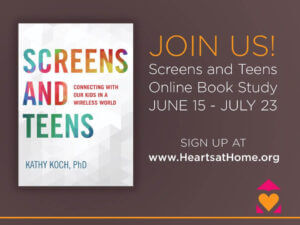 Today’s post is another wonderful excerpt from Dr. Kathy Koch’s newest Hearts at Home book, Screens and Teens.
Today’s post is another wonderful excerpt from Dr. Kathy Koch’s newest Hearts at Home book, Screens and Teens.
If you’re looking for a summer reading selection for you or you and your spouse, consider Screens and Teens: Connecting with Our Kids in a Wireless World. In fact, Hearts at Home is offering a FREE summer online study for the Screens and Teens. Pick up a copy, sign up, and join the discussion!
Dr. Kathy is also a speaker at our 2015 Hearts at Home conferences. Registration is now OPEN for our North Central Regional Conference in Rochester, MN, November 14-15, 2015.
*******************************************************************************
 Teens believe they need choice and that choices are their right for two primary reasons: the variety of the options always available to them and the drop-down menus used by so many technology tools, toys, and services.
Teens believe they need choice and that choices are their right for two primary reasons: the variety of the options always available to them and the drop-down menus used by so many technology tools, toys, and services.
For some kids, there’s a third cause. If they have premature freedom to make decisions and they regularly do what they want, freedom of choice will be their expectation. So, if we’ve prioritized happiness to keep the peace, and recognize we’ve contributed to the culture of “I don’t want that, I want this,” let’s own it and talk about it with our teens as we work to improve our relationship and their future.
Of course technology has contributed to this lie being believed by many, many young people. In one minute Instagram users post 216,000 new photos and YouTube users upload 72 hours of new video. You read that right—every minute we have 72 more hours of video to choose from. Spotify allows us to choose from among more than 20 million songs and iTunes Radio has more than 27 million. There are almost 1 billion websites. It’s no wonder teens believe the lie that they deserve choices!
Choice shows up everywhere. Like me, you may remember a time when there were just a few restaurants near your home. Going out to eat might have been a rare treat. In contrast, many of our children have eaten out often. Not only that, but think how the number of choices at these restaurants has increased over the years. Just thinking about the options at my local coffee bar makes my head spin.
There’s another contrast with the “old days” relevant to this lie. When I was a teen, biblical morality was the norm. There was great consistency in a community, and even in our country, as to what constituted right and wrong. This naturally decreased options and limited choices. Of course, not everybody thought then or thinks now that this is a good thing. However, we can’t deny that it narrowed choices.
When a teacher assigned a paper of 300 words due Tuesday, we wrote a paper that long and turned it in on Tuesday. When a youth pastor said permission slips needed to be turned in the Saturday before camp, we knew to turn ours in by then if we wanted to go. When a parent or grandparent asked us to help with the dishes, it would have been unthinkable to beg off or suggest someone else help instead.
What emotional responses are you having to these illustrations? Do you relate to a different time, or do you relate more to this generation of choices? Let’s find out more about this demand for choice and one way it’s affecting teens.
As appealing as choices are, and as necessary as teens believe they are, too much of a good thing isn’t always a good thing. Consider this. I have so many CDs on my desk that I sometimes don’t want to have to decide which one to listen to so I turn on the radio instead. I let the producer of that show make decisions for me. (Yes, it’s true: I still use ancient technology called a “CD player.” I paid for my CDs, my CD player still works, so I use them.) When it comes to too many choices, paralysis rather than liberation is a common occurrence.
 So how can we help young people maintain equilibrium when they are inundated with so many choices they could be overwhelmed?
So how can we help young people maintain equilibrium when they are inundated with so many choices they could be overwhelmed?
1. We can help our teens know that it’s okay to change their minds sometimes. Many teens want to make right decisions and are afraid they’ll be wrong or they’ll change their mind. We can explain that changing their mind doesn’t mean they were wrong or they failed. It’s often the case that what is right today isn’t going to be right a month from now. Maybe the situation changed, or we’ve gained better information about people or a situation. Rethinking a decision doesn’t always mean the first decision was wrong.
2. We can provide helpful feedback so choosing doesn’t seem so overwhelming. We can help teens think through why a choice was wise or not. If it was unwise, was it because the choice was dangerous, selfish, immature, or lazy? We can help them analyze their wise decisions, too. What past experience guided them to a smart choice? Did they integrate your feedback into their thinking? Were they efficient, creative, or something else? We can also help them anticipate how similar thinking could be relevant to future decisions.
3. We can limit choices when possible. Because they are forced to make so many choices all the time, we can help them narrow down choices when possible. We might do this when looking at colleges or choosing classes at school. Rather than looking at all the options in front of them, narrow the choices to some of the best options for them. Talk about simple ways to disqualify options to make some choices easier.
Used with Permission. Copyright 2015 by Kathy Koch.
What about you? How have you helped your teens deal with choices?











